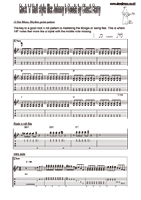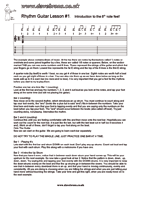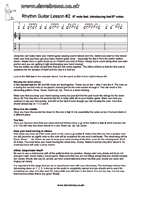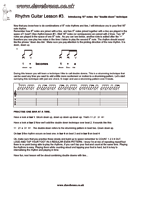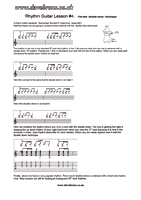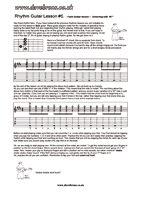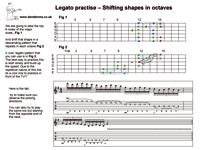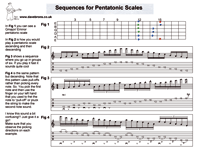These are lessons aimed at beginners to help develop strumming patterns, playing in time and counting.
These lessons cover how to play the following rhythm styles; rock, funk, soul, reggae, jazz, country, and others.
These lessons are mainly reference lessons, which wil enable you how to play scales and chords anywhere on the neck.
Lesson #1 - Scale tone chords
This lesson will show you how to learn what chords are in a key. This is important to know because it helps you play songs by ear, and change the key easily. The major scale is formed as follows tone, tone,semi-tone, tone, tone, tone, semitone. (A tone is 2 frets up and a semitone is 1 fret up).
In the PDF files to the right The red dots are the scale notes. Each note has a chord built on top of it the root note has a major chord built on it , the second a minor chord then minor, major, major, minor, dom etc.
Practise each note of the scale, then go up 1 chord at a time.
|
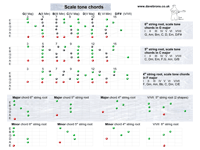 |
Lesson #2 - How to build a major or minor scale on a chord.
I view scales as chords with passing notes. So if a song is in G major.eg. The chords are G C D and Em Try making up melodies. First with the G major arpeggio, Then add a few more notes to form the Pentatonic scale. Finally when you are confident add the rest of the notes and make up melodies with all the 7 notes of the major scale If the song is in the rel min eg.Em G C D take the same approach but build the arpeggio on on the chord, then the minor pentatonic scale and finally the full minor scale.
|
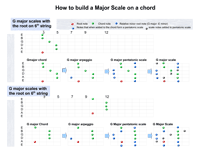 |
Lesson #3 - Understanding the neck of your guitar using the CAGED system
the caged system is a way of breaking the neck up into 5 positions. Each of these positions are based around 5 ways of playing the same major chord . These chord shapes derive their names from major chord shapes in an open position that they resemble. C shape, an A shape a G shape, an E shape and a D shape the best way to learn this is to learn the chord shapes first...then practice them ascending and descending the neck. After you have mastered this practise ascending one scale and descending the next scale shape.
|
 |
Lesson #4 - Learning 5 pentatonic scale positions
This builds further on the CAGED system by showing each pentatonic scale position. Practice each scale ascending then descending. If you get bored but a record on and jam along.
|
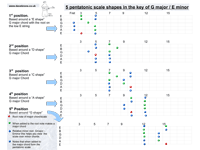 |
Lesson #5 The Major Scale in 5 positions
Now that you have learnt all the pentatonic scales and chords you are ready to move on to full scales. Practise the chord, and also visualise which pentatonic scale each major scale is based on. Learn one shape at a time by playing the chord, then the pentatonic scale and finally the full scale. This will take a lot of practice, but if you learn all these scales you will have finally unlocked the code to playing all over the guitar, (a never ending journey of discovery)
|
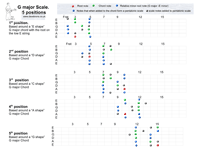 |
Lesson #6 Playing all the scale tone chords in one position
This lesson takes the concept of.scale tone chords one step further by showing you how to play all chords without moving out of position....this makes it easy to play jazz style solos where you add chords to your melodies, it is also great for swapping between solos and funky chord riffs. Close your eyes visualize each shape and then play them.
I will be adding more rescources like videos and advanced lessons on how to play fast, insane terror guitar licks keep watching this space.
|
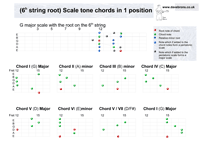 |
Lesson #7 Modes
This lesson will show you shapes for each of the 7 major scale modes. It will also teach you how to get some weird and wonderful sounds, including te chord and pentatonic shapes behind each mode. |
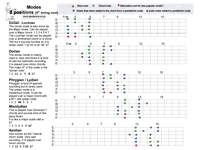
|
Lesson #8 Mixolydian Dominant Arpeggio Substitution
Are you bored of always playing the same old blues scales over the dominant 7 chords? This lesson will show you how you can play not only dominant 7 arpeggios but also minor 7b5 and major 7 arpeggios over dominant 7 chords to get some really interesting sounds. |
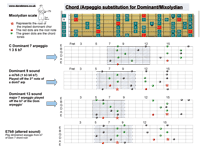 |
Lesson #9 Dominant 7 arpeggio substitution
This lesson will teach you how to spice up your 12 bar blues progressions with less obvious arpeggio choices. |
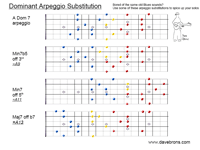 |
Lesson #10 Minor 7 arpeggio substitution
Learn how to use arpeggio shapes other than minor to get some cool sounds. |
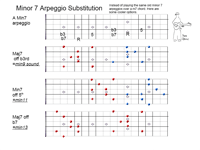 |
Lesson #11 Dominant Danger Scales
WATCH OUT! Those scales are dangerous! |
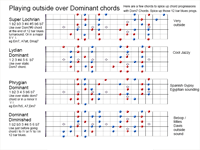 |
Lesson #12 Melodic minor modes
(See title). |
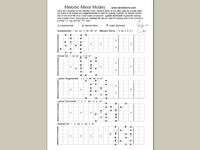 |
Lesson #13 Harmonic minor modes
Miners, Harmonicas both of which have nothing to do with this lesson. |
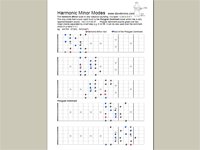 |
Lesson #1 - How are chords built?
This lesson explains the theory around basic major and minor chords. So
next time someone asks "why does A major have a C#'' you can smuggly
respond ''Because!" confident in the knowledge that you know more than them!
Alternatively you could be a good sport and say ''because major chords
have a major third and minor chords have a flat 3rd, Stupid "
|
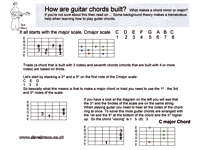 |
Lesson #2 - Suspended Chords
This what the 7 is after some chords. Contrary to what some old wives say
they are not "lucky chords", Neither do they pick on other weaker little
chords just because they are dominant.
|
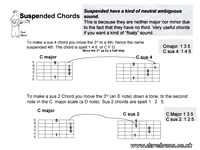 |
Lesson #3 - Seventh Chords
Ride the 7th wave! *
Seventh chords are not really any luckier than any other chord, in fact
they are found a lot in Blues music so you could argue that they are quite
unlucky. Anyway, here is a description of Minor, major and Dominant seven
chords.
*( This is a surfing reference to the 7th wave in a set always the best
one. To be honest I haven't really found this to be true, but I digress...) |
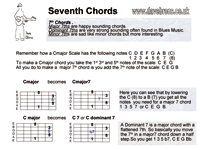 |
Lesson #4 - Diminished chords and
Scale tone chords
Diminished chords are strange and cool little chords that strike fear and confusion into the heart of guitarists when they pop up unexpectedly in the middle of nice easy chord sequences.
|
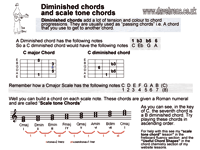 |
Lesson #5 - Slash Chords
Slash chords like D/F# are not as violent as they sound. Understanding them will unlock lots of cool sounds. It will also help you understand those mentally lazy keyboard players who keep going on about C/A chords rather than calling it Am7 which is what the chord should be called in the first place....don't get me started on classically trained pipe organists! |
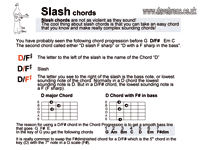 |
Lesson #6 - Chord Dictionary
All the chords you'll ever need, and a few you wont. |
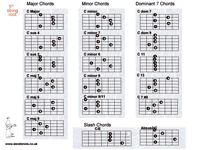 |
Lesson #7 - Open chord glossary
Great reference for beginners. It has all the basic chords you'll need. |
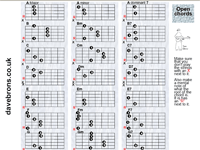 |
Lesson #8 - Drop 2 chord Voicings
Ever wondered how jazz guitar players can play 14 chords and all that is written on the score is 1 chord? Well here's some of the secrets to playing chords all over the place. |
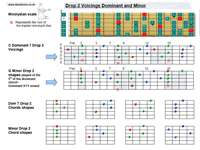 |

